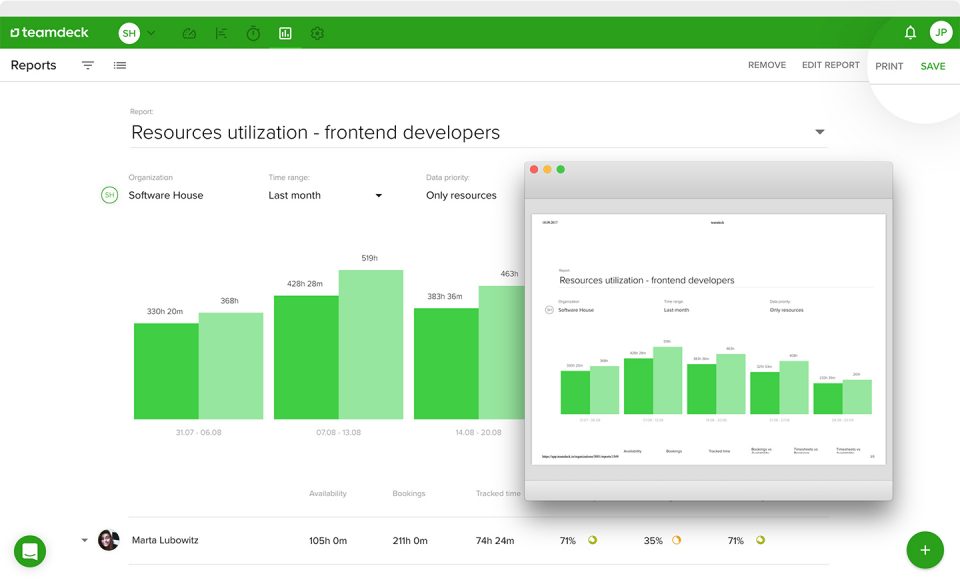Molte aziende sono attualmente alla ricerca di idee per l'ottimizzazione dei costi in risposta alla pandemia globale e alle sue conseguenze economiche. Nel tentativo di ridurre al minimo i costi delle risorse umane, i team decidono di attuare il blocco delle assunzioni o utilizzare in modo più efficace la tecnologia HR, il tutto per mantenere la redditività ed evitare i licenziamenti. Nello spirito di fare un uso migliore della tecnologia disponibile, vogliamo mostrarvi come le aziende possono ridurre i costi aziendali con gestione delle risorse del progetto.
I nostri suggerimenti sono validi per molti settori verticali diversi, ma le aziende che lavorano per più clienti alla volta (agenzie, società di consulenza, software house) li troveranno forse particolarmente utili. Infatti, quando ci si destreggia tra più progetti contemporaneamente, pianificare e gestire le risorse è molto impegnativo.
Innanzitutto, definiamo la gestione delle risorse.
Che cos'è la gestione delle risorse?
Nel nostro guida a gestione delle risorse del progetto, lo abbiamo definito come fare l'uso più efficiente possibile delle risorse limitate a disposizione. Di che tipo di risorse stiamo parlando? Di persone, naturalmente, ma anche di attrezzature, locali, veicoli o altro, a seconda della natura della vostra azienda. In questo post, tuttavia, ci concentreremo sulla gestione delle risorse umane.
Fare un uso ottimale delle risorse significa utilizzarle in modo efficiente, assegnare le persone giuste ai progetti giusti (allocazione delle risorse)e analizzare il lavoro del team per trovare opportunità di ottimizzazione. Questi passaggi sono fondamentali per ridurre i costi aziendali, come si vedrà nei prossimi paragrafi.
Utilizzo buono software di pianificazione delle risorse vi aiuterà enormemente. Naturalmente, l'applicazione non farà tutto il lavoro al posto vostro, ma vi permetterà di fare le cose in modo efficiente, risparmiando tempo e denaro. In questo blog post, vedrete le schermate di Teamdeck, un'applicazione utilizzata da squadre di tutto il mondo.
In che modo una gestione efficace delle risorse vi aiuterà a risparmiare?
Sviluppare TeamdeckCome azienda di gestione delle risorse, parliamo spesso con i nostri clienti dell'effetto che la gestione delle risorse ha sui loro bilanci.
Apptension è stata una delle prime aziende a utilizzare Teamdeck per pianificare e gestire il lavoro dei propri dipendenti. Piotr Bandosz, responsabile delle finanze e delle persone di Apptension, ci ha detto:
Senza Teamdeck, ogni mese sprecavamo $11.130 di tempo dei dipendenti per affrontare le comuni difficoltà manageriali. Teamdeck ci ha aiutato a ridurre questo spreco a $1.249,50, con un risparmio di $9.880,50 al mese.
Apptension è un team di 50 persone, quindi se gestite un'azienda più grande potete aspettarvi un risparmio ancora maggiore. Come è possibile? Entriamo nei dettagli: come si risparmia quando si implementa la gestione delle risorse?
Miglioramento dell'utilizzo delle risorse
Perché è utilizzo delle risorse così cruciale? In breve: è un vantaggio sia per il datore di lavoro che per i dipendenti. Pensiamo ad esempio al sottoutilizzo. Le persone che aspettano di svolgere i compiti generano costi per l'azienda, ma possono anche si sentono molto frustrati. D'altro canto, l'utilizzo eccessivo può portare a burnout dei dipendenti e i costi aggiuntivi per il datore di lavoro se si paga di più per straordinario. È molto semplice: con un utilizzo ottimale, non si generano costi inutili e i membri del team possono godere di un'ottima salute. equilibrato carico di lavoro del team.
La gestione delle risorse è fondamentale per mantenere un buon utilizzo delle stesse. Richiede di prestare attenzione a pianificazione delle risorse e assegnare il lavoro ai dipendenti che possono svolgere più compiti. Quando si visualizzano le prenotazioni di tutti i membri del team nel calendario delle risorseÈ molto più facile individuare le persone sottoutilizzate o sovrautilizzate.







